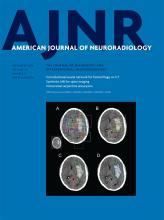Index by author
Bendszus, M.
- InterventionalYou have accessInvestigation of a New Version of the Liquid Embolic Agent PHIL with Extra-Low-Viscosity in an Endovascular Embolization ModelD.F. Vollherbst, R. Otto, M. Hantz, C. Ulfert, H.U. Kauczor, M. Bendszus, C.M. Sommer and M.A. MöhlenbruchAmerican Journal of Neuroradiology September 2018, 39 (9) 1696-1702; DOI: https://doi.org/10.3174/ajnr.A5750
- Extracranial VascularYou have accessValue of Contrast-Enhanced MRA versus Time-of-Flight MRA in Acute Ischemic Stroke MRIT. Boujan, U. Neuberger, J. Pfaff, S. Nagel, C. Herweh, M. Bendszus and M.A. MöhlenbruchAmerican Journal of Neuroradiology September 2018, 39 (9) 1710-1716; DOI: https://doi.org/10.3174/ajnr.A5771
Bergsland, N.
- Extracranial VascularOpen AccessFive-Year Longitudinal Study of Neck Vessel Cross-Sectional Area in Multiple SclerosisL. Pelizzari, D. Jakimovski, M.M. Laganà, N. Bergsland, J. Hagemeier, G. Baselli, B. Weinstock-Guttman and R. ZivadinovAmerican Journal of Neuroradiology September 2018, 39 (9) 1703-1709; DOI: https://doi.org/10.3174/ajnr.A5738
Blitz, A.M.
- FELLOWS' JOURNAL CLUBHead & NeckYou have accessContrast-Enhanced CISS Imaging for Evaluation of Neurovascular Compression in Trigeminal Neuralgia: Improved Correlation with Symptoms and Prediction of Surgical OutcomesA.M. Blitz, B. Northcutt, J. Shin, N. Aygun, D.A. Herzka, D. Theodros, C.R. Goodwin, M. Lim and D.P. SeeburgAmerican Journal of Neuroradiology September 2018, 39 (9) 1724-1732; DOI: https://doi.org/10.3174/ajnr.A5743
Retrospective review of high-resolution MRIs was performed in patients without prior microvascular decompression. 3D-CISS imaging without and with contrast for 81 patients with trigeminal neuralgia and 15 controls was intermixed and independently reviewed in a blinded fashion. Cisternal segments of both trigeminal nerves were assessed for the grade of neurovascular conflict, cross-sectional area, and degree of flattening. Contrast-enhanced CISS more than doubled the prevalence of the highest grade of neurovascular conflict (14.8% versus 33.3%) and yielded significantly lower cross-sectional area and greater degree of flattening for advanced-grade neurovascular conflict on the symptomatic side compared with non-contrast-enhanced CISS.
Bobinski, M.
- Patient SafetyYou have accessGadolinium Deposition within the Pediatric Brain: No Increased Intrinsic T1-Weighted Signal Intensity within the Dentate Nucleus following the Administration of a Minimum of 4 Doses of the Macrocyclic Agent GadoteridolJ.R. Young, W.B. Pope and M. BobinskiAmerican Journal of Neuroradiology September 2018, 39 (9) 1604-1608; DOI: https://doi.org/10.3174/ajnr.A5748
Boespflug-tanguy, O.
- Adult BrainOpen AccessAdult-Onset Leukoencephalopathy with Axonal Spheroids and Pigmented Glia: An MRI Study of 16 French CasesP. Codjia, X. Ayrignac, F. Mochel, K. Mouzat, C. Carra-Dalliere, G. Castelnovo, E. Ellie, F. Etcharry-Bouyx, C. Verny, S. Belliard, D. Hannequin, C. Marelli, Y. Nadjar, I. Le Ber, I. Dorboz, S. Samaan, O. Boespflug-Tanguy, S. Lumbroso and P. LabaugeAmerican Journal of Neuroradiology September 2018, 39 (9) 1657-1661; DOI: https://doi.org/10.3174/ajnr.A5744
Boto, J.
- EDITOR'S CHOICESpineYou have accessFeasibility of a Synthetic MR Imaging Sequence for Spine ImagingM.I. Vargas, M. Drake-Pérez, B.M.A Delattre, J. Boto, K.-O. Lovblad and S. BoudabousAmerican Journal of Neuroradiology September 2018, 39 (9) 1756-1763; DOI: https://doi.org/10.3174/ajnr.A5728
Thirty-eight patients with clinical indications of infectious, degenerative, and neoplastic disease underwent an MR imaging of the spine. The SyntAc sequence, with an acquisition time of 5 minutes 40 seconds, was added to the usual imaging protocol consisting of conventional sagittal T1 TSE, T2 TSE, and STIR TSE. The image quality was rated as “good” for both synthetic and conventional images. Interreader agreement concerning lesion conspicuity was good with a Cohen kappa of 0.737. The authors conclude that the study shows that synthetic MR imaging is feasible in spine imaging and produces, in general, good image quality and diagnostic confidence.
Boudabous, S.
- EDITOR'S CHOICESpineYou have accessFeasibility of a Synthetic MR Imaging Sequence for Spine ImagingM.I. Vargas, M. Drake-Pérez, B.M.A Delattre, J. Boto, K.-O. Lovblad and S. BoudabousAmerican Journal of Neuroradiology September 2018, 39 (9) 1756-1763; DOI: https://doi.org/10.3174/ajnr.A5728
Thirty-eight patients with clinical indications of infectious, degenerative, and neoplastic disease underwent an MR imaging of the spine. The SyntAc sequence, with an acquisition time of 5 minutes 40 seconds, was added to the usual imaging protocol consisting of conventional sagittal T1 TSE, T2 TSE, and STIR TSE. The image quality was rated as “good” for both synthetic and conventional images. Interreader agreement concerning lesion conspicuity was good with a Cohen kappa of 0.737. The authors conclude that the study shows that synthetic MR imaging is feasible in spine imaging and produces, in general, good image quality and diagnostic confidence.
Boujan, T.
- Extracranial VascularYou have accessValue of Contrast-Enhanced MRA versus Time-of-Flight MRA in Acute Ischemic Stroke MRIT. Boujan, U. Neuberger, J. Pfaff, S. Nagel, C. Herweh, M. Bendszus and M.A. MöhlenbruchAmerican Journal of Neuroradiology September 2018, 39 (9) 1710-1716; DOI: https://doi.org/10.3174/ajnr.A5771
Bruesewitz, M.R.
- Head & NeckOpen AccessComparison of a Photon-Counting-Detector CT with an Energy-Integrating-Detector CT for Temporal Bone Imaging: A Cadaveric StudyW. Zhou, J.I. Lane, M.L. Carlson, M.R. Bruesewitz, R.J. Witte, K.K. Koeller, L.J. Eckel, R.E. Carter, C.H. McCollough and S. LengAmerican Journal of Neuroradiology September 2018, 39 (9) 1733-1738; DOI: https://doi.org/10.3174/ajnr.A5768
Bulut, E.
- PediatricsYou have accessBrachial Plexus Ultrasound and MRI in Children with Brachial Plexus Birth InjuryA. Gunes, E. Bulut, A. Uzumcugil and K.K. OguzAmerican Journal of Neuroradiology September 2018, 39 (9) 1745-1750; DOI: https://doi.org/10.3174/ajnr.A5749








